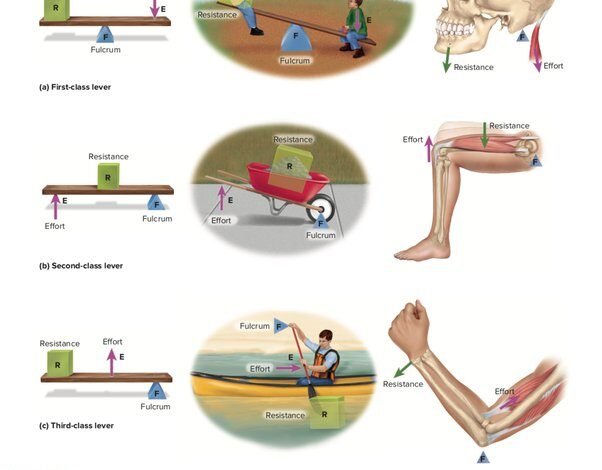Explain What Distinguishes First Class Levers From Second And Third

Levers are simple machines that help us lift, move, or balance objects. They are classified into three types: first class, second class, and third class levers.
Each type of lever works differently and serves unique purposes in daily life and engineering. Understanding the differences between these levers is essential for both students and professionals. First class levers have the fulcrum between the effort and load. Second class levers position the load between the fulcrum and effort.
Third class levers place the effort between the fulcrum and load. This introduction will help you grasp the basic distinctions and significance of each lever type. By the end, you will know how they function and where you might encounter them in real-world applications.

Credit: study.com
Introduction To Levers
Levers are fundamental tools in mechanics and physics. They make work easier by using a pivot point to multiply force. Understanding levers helps in various applications, from simple machines to complex engineering systems.
Definition Of Levers
A lever is a rigid bar that rotates around a fixed point called a fulcrum. It is used to move a load with less effort. Levers are classified based on the positions of the fulcrum, effort, and load.
There are three classes of levers:
- First Class Levers: Fulcrum is between the effort and the load.
- Second Class Levers: Load is between the fulcrum and the effort.
- Third Class Levers: Effort is between the fulcrum and the load.
Importance In Mechanics
Levers are crucial in mechanics for several reasons:
- Efficiency: Levers reduce the amount of force needed to move objects.
- Versatility: They are used in many tools and machines.
- Mechanical Advantage: Levers provide a mechanical advantage, making tasks easier.
Understanding the different classes of levers is important. It helps in designing and using tools effectively.
Here is a table to summarize the key differences:
| Class | Fulcrum Position | Effort Position | Load Position |
|---|---|---|---|
| First Class | Between effort and load | On one end | On the other end |
| Second Class | On one end | On the other end | Between fulcrum and effort |
| Third Class | On one end | Between fulcrum and load | On the other end |
By knowing these basics, you can better understand and apply the principles of levers.
First Class Levers
First class levers are simple machines that make work easier. These levers have a specific structure. They help us lift or move heavy objects with less effort. Understanding their structure and components can help us see how they work in everyday life.
Structure And Components
A first class lever has three main parts: the fulcrum, the effort, and the load. The fulcrum is the pivot point. It is in the middle of the lever. The effort is the force applied to one end of the lever. The load is the object being moved. It is at the other end. This setup means the effort and load are on opposite sides of the fulcrum.
The fulcrum’s position changes the lever’s effectiveness. If the fulcrum is closer to the load, less effort is needed. If the fulcrum is closer to the effort, more effort is needed. This balance makes first class levers versatile tools.
Examples In Everyday Life
First class levers are common in daily activities. A seesaw is a perfect example. The fulcrum is in the middle, with children sitting on either side. When one child pushes down, the other rises. Scissors are another example. The fulcrum is where the blades cross. The handles are where you apply effort. The blades cut the load.
Pliers also work as first class levers. The fulcrum is the joint. The handles are where you apply effort. The jaws grip the load. These examples show how first class levers help in everyday tasks. They make work easier by changing the amount of effort needed.
Mechanics Of First Class Levers
First class levers are common in everyday life. They consist of a fulcrum, load, and effort. Understanding these levers helps in physics and engineering. They balance forces efficiently.
Fulcrum Position
In first class levers, the fulcrum is between the effort and load. This central position allows for efficient force distribution. Examples include seesaws and crowbars. The fulcrum’s placement can vary, affecting force and movement.
Force And Load Distribution
First class levers balance effort and load around the fulcrum. The distance from the fulcrum to the effort affects force needed. A longer distance requires less effort to lift the load. This principle is key in many tools and devices. It allows for easier lifting and movement.
Second Class Levers
Second class levers are unique and useful in everyday life. They offer a mechanical advantage, making it easier to lift heavy objects.
Structure And Components
A second class lever has three main parts:
- Fulcrum: The pivot point of the lever.
- Load: The weight or resistance to be moved.
- Effort: The force applied to move the load.
In second class levers, the load is positioned between the fulcrum and the effort. This setup allows the effort to lift the load with less force.
Here’s a simple table to illustrate the structure:
| Component | Position |
|---|---|
| Fulcrum | At one end |
| Load | Between fulcrum and effort |
| Effort | At the opposite end of the fulcrum |
Common Examples
Second class levers are common in daily life. Some examples include:
- Wheelbarrow: The wheel acts as the fulcrum, the load is in the container, and the effort is applied at the handles.
- Nutcracker: The hinge is the fulcrum, the nut is the load, and the effort is applied at the handles.
- Bottle opener: The fulcrum is at the edge of the cap, the load is the cap, and the effort is applied at the handle.
These examples show how second class levers make work easier. They reduce the amount of force needed to move heavy loads.
Mechanics Of Second Class Levers
Second class levers are unique in their mechanics. They offer specific advantages in force application. Understanding these mechanics can help in various practical applications.
Fulcrum Position
In second class levers, the fulcrum is at one end. The load is between the fulcrum and the effort. This setup makes second class levers effective in lifting heavy loads.
Efficiency In Force Application
Second class levers apply force efficiently. They require less effort to move a load. This is because the effort arm is longer than the load arm. Examples include wheelbarrows and bottle openers. These tools make tasks easier by reducing the needed force.

Credit: www.youtube.com
Third Class Levers
Third class levers play a significant role in our daily activities. These levers are efficient and versatile. Understanding their structure and common uses helps us appreciate their importance.
Structure And Components
Third class levers have a distinct structure. They consist of three main parts: the effort, the fulcrum, and the load.
In this type of lever, the effort is applied between the fulcrum and the load. This positioning makes third class levers unique. The effort arm is always shorter than the load arm.
Here is a table to illustrate the structure:
| Component | Position |
|---|---|
| Fulcrum | At one end |
| Effort | Between fulcrum and load |
| Load | At the opposite end from the fulcrum |
The specific arrangement allows for rapid, precise movements. Third class levers are powerful but require more effort to move the load.
Everyday Examples
Third class levers are common in everyday life. They include tools and body parts. Here are some examples:
- Broom: The hand closest to the bristles is the fulcrum. The hand in the middle applies the effort. The load is the dirt being swept.
- Tweezers: The fulcrum is at the end where the two arms are joined. The effort is applied in the middle. The load is whatever you are picking up.
- Human arm: The elbow acts as the fulcrum. The bicep muscle applies the effort between the elbow and hand. The load is whatever you are lifting.
These examples demonstrate the versatility of third class levers. They make tasks easier and more efficient.
Mechanics Of Third Class Levers
Third class levers are common in the human body. These levers are efficient for tasks that require speed and a wide range of motion. Understanding their mechanics can be insightful, especially in fields like sports and physical therapy.
Fulcrum Position
In third class levers, the fulcrum is positioned at one end. The effort is applied between the fulcrum and the load. This arrangement is different from first and second class levers.
For example, the biceps in the human arm act as a third class lever. The elbow joint serves as the fulcrum. The effort is applied by the biceps muscle, and the load is the weight in your hand.
Speed And Range Of Motion
Third class levers are designed for speed and a large range of motion. They are less effective at moving heavy loads but excel in quick and wide movements.
Consider the human arm again. Lifting a small object quickly is easier than lifting a heavy object. The structure of third class levers allows for this efficiency.
Advantages:
- Increased speed
- Greater range of motion
Disadvantages:
- Less force production
- Not suitable for heavy lifting
Understanding third class levers can help in designing better physical training programs. It can also aid in improving performance in activities requiring quick movements and agility.
Comparing First, Second, And Third Class Levers
Levers are simple machines that help us lift or move loads with less effort. They are classified into three types: first, second, and third class levers. Each type has unique features that suit specific tasks. Understanding these differences can help us use levers more effectively in everyday life.
Key Differences
The main difference between the three classes of levers is the arrangement of the fulcrum, effort, and load. This arrangement determines how each lever functions.
| Class | Fulcrum Position | Load Position | Effort Position |
|---|---|---|---|
| First Class | Between load and effort | On one side of the fulcrum | On the opposite side of the load |
| Second Class | At one end | Between fulcrum and effort | At the opposite end of the fulcrum |
| Third Class | At one end | At the opposite end | Between fulcrum and load |
First class levers have the fulcrum between the load and effort. In second class levers, the load lies between the fulcrum and effort. Third class levers place the effort between the fulcrum and load.
Practical Applications
Different lever classes are used in various real-life applications. Each type offers unique advantages.
- First Class Levers
- Seesaws
- Scissors
- Pliers
- Second Class Levers
- Wheelbarrows
- Nutcrackers
- Bottle openers
- Third Class Levers
- Tweezers
- Fishing rods
- Bicep muscles lifting the forearm
First class levers are ideal for tasks that need a balance of force and precision. Second class levers are perfect for lifting heavy loads with less effort. Third class levers are used in activities that require speed and range of motion.

Credit: www.youtube.com
Frequently Asked Questions
What Are First Class Levers?
First class levers have the fulcrum located between the effort and the load. This arrangement allows for balanced movement.
How Do Second Class Levers Work?
In second class levers, the load is positioned between the fulcrum and the effort. This setup provides a mechanical advantage.
Where Can I Find Third Class Levers?
Third class levers have the effort placed between the fulcrum and the load. They are common in human body movements.
What Is The Main Difference Between Lever Classes?
The primary difference lies in the position of the fulcrum, effort, and load. Each class offers different mechanical advantages.
Conclusion
First class levers have the fulcrum between load and effort. Second class levers place the load between fulcrum and effort. Third class levers position effort between fulcrum and load. Each type has unique advantages. First class levers provide balance. Second class levers offer strength.
Third class levers give speed. Understanding these differences helps in everyday applications. From scissors to wheelbarrows, levers play a vital role. Knowing lever types enhances problem-solving skills. They make tasks easier and more efficient. Levers are simple, yet powerful tools.
Recognize their types. Use them wisely.



